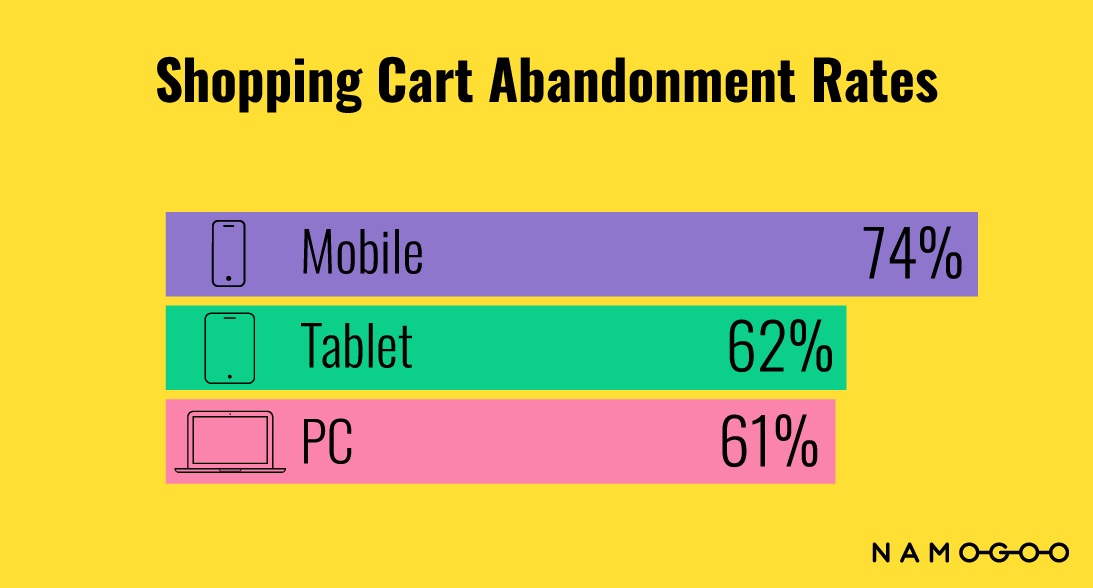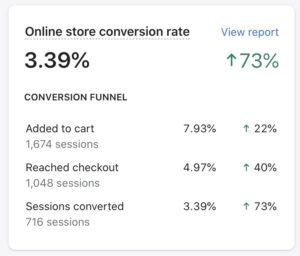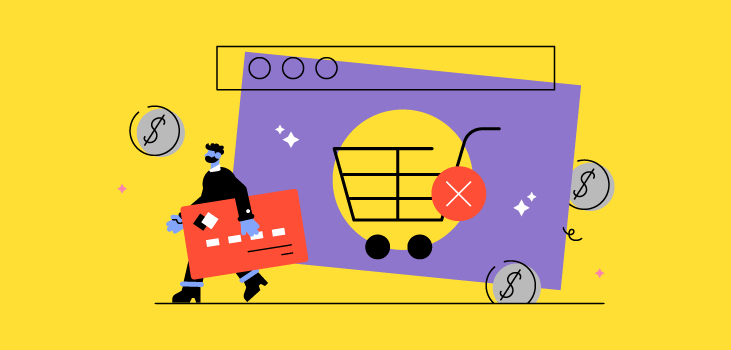Bonus material: Shopping Cart Abandonment Industry Benchmark Report
This is the complete guide to digital shopping cart abandonment in 2021.
Reducing shopping cart abandonment rate is a focus of most eCommerce teams for good reason: it’s a huge problem.
So in this guide, you’ll learn everything there is to know about this eCommerce metric.
WHAT IS SHOPPING CART ABANDONMENT?
Shopping cart abandonment is an eCommerce event that tracks the number of customers who add items to an online shopping cart but fail to check out and complete their purchase.
In our analysis of over 2 billion weekly eCommerce shopping sessions, we found that 69% of all shopping carts never make it to the checkout stage.
That means for every 100 carts that are created, nearly 70 will never convert. New customers and those on mobile devices are even more likely to abandon their carts.

Cart abandonment is expressed as the percentage of carts created that don’t complete their purchase, and it’s referred to as “cart abandonment rate”.
Cart abandonment rate is an essential metric for eCommerce teams because it shows the number of customers that are interested in buying from your store, but were thwarted somehow.
Figuring out why customers abandon carts (and fixing it!) is a quick way to improve conversion rates, drive revenue, and ensure customer journey continuity.
HOW TO CALCULATE SHOPPING CART ABANDONMENT RATE
Cart abandonment rate is calculated by dividing the total number of purchases completed by the number of carts created and then multiplying that number by 100.
For example:

Abandonment rate can be calculated over any period of time, and fluctuation of the rate over a period is normal due to the sales promotions and marketing campaigns being run. Most eCommerce teams track and monitor average abandonment rates monthly.
There is more to cart abandonment than just the number of people who don’t complete their purchase. You’ll also want to pay attention to how the metrics change over time and whether factors like location or device impact abandonment rates.
For example, if abandonment rates are much higher on mobile devices, check to see if buttons or form fields are too small to easily tap on a mobile phone or offer easier ways to pay, like Paypal rather than credit cards.
How to Find eCommerce Cart Abandonment Rates
Rather than regularly re-calculating your eCommerce store’s abandonment rate, you may want to use a metric tracking tool.
Some eCommerce platforms and analytics tools track cart abandonment rates so you can monitor it in your KPI dashboard. Here’s how to find your store’s rate on various platforms.
Shopify
Shopify doesn’t report abandonment rates on their native dashboards, so unless you use a third-party analytics service like Glew, Mixpanel, or Heap, you’ll have to crunch the numbers yourself.
You can find the numbers in your Shopify dashboard, under the Online store conversion rate report.

Just select the dates you want to track, and plug the numbers into your team’s dashboard or growth model.
In this example, the abandonment rate for the month is:
(716 / 1674) x 100 = 43%
Google Analytics
You can easily find your cart abandonment rate in Google analytics under Conversions > Goals > Funnel Visualization.

Google Analytics will provide this data at the product level as well. It’s common for GA’s numbers to not agree perfectly with your eCommerce platform, but the important thing is to choose a source of truth and stick with it for all reporting.
Note that to view this metric in Google Analytics, you’ll need enhanced eCommerce enabled.
TYPES OF ECOMMERCE ABANDONMENT
Other than shopping cart abandonment, there are also different types of abandonment your eCommerce customers might engage in.
These include:
- Browse: Users who bounce from a website after viewing product pages.
- Checkout: The customer exited at the checkout stage of the onsite conversion path, after having entered some of their personal information.
The type of abandonment and the reasons for abandonment impacts which strategies are most effective for recovering abandoned sessions. We’ll cover this later in the article.
Is Shopping Cart Abandonment Different From Bounce Rate?
Yes, shopping cart abandonment rate and bounce rate are very different.
Cart abandonment rate tracks the number of people who abandon during the buying process, while bounce rate tracks the number of site visitors who visit just one page before leaving[*].
The biggest difference between cart abandonment and bounce rate is customer purchase intent.
- Cart abandonment tracks customers who had some level of intent to purchase (otherwise, they wouldn’t have added an item to their cart!)
- Bounce rate tracks visitors who leave your site — no matter why they leave or why they came.
Visitors that bounce did not necessarily have an intent to purchase. They may have Googled a question or clicked on a friend’s link on social media. They didn’t necessarily give any indication of the buyer’s intent.
Improving bounce rate and cart abandonment rates is vital to overall eCommerce success; just keep in mind these metrics track very different types of customers.
SHOPPING CART ABANDONMENT EFFECTS
The reality is, not every person who adds an item to their cart will convert, no matter how hard you try to prevent cart abandonment.
This of course leads to lost revenue and sales, which is the reason most eCommerce teams want to focus on cart recovery strategies.
But the damaging effects of shopping cart abandonment reach further than just your sales figures. Here are some of the ways this can negatively impact eCommerce brands:
- Lost revenue and conversions: The most obvious effect of cart abandonment. If your cart abandonment rate tracks toward the average cited above (69%), and your average order value is $60, then for every 1000 orders you do make, you’d lose 690 — which translates to nearly $500,000 per year lost to abandonment.

This can be especially harmful because of customer journey highjacking and a loss of customer lifetime value.
- Reduces inventory and availability: eCommerce stores that sell physical products lose sales when inventory is low due to items languishing in carts that never convert. Bookings for consulting meetings or hotel rentals can also be impacted by reducing the number of available slots.
- Lowers ROI: Losing customers at the last minute due to cart abandonment can lower your overall ROI, which can impact just about every other metric you’re tracking. Lower landing page conversions or low sales on a new item might be due to UX errors, rather than poor-performing copy or lack of interest. You won’t know if you aren’t tracking checkout abandonment in addition to other metrics.
- Skews your data: Cart abandonment can make it difficult to understand what marketing and sales strategies are working. Say a Facebook ad drives 5,000 site visitors but 50 end up abandoning their cart. You might think your Facebook ad isn’t working when in reality the ad is great; it’s your checkout process causing the issues.
Lost carts don’t just impact your revenue — they can impact your brand across the board.
So, what is the solution? Start by understanding why visitors abandon their carts, so you can maximize your cart recovery efforts.
WHY ONLINE SHOPPERS ABANDON THEIR CARTS
Ideally, every visitor who adds an item to their cart will complete the conversion process. But that’s not reality.
Online shoppers abandon their carts for many reasons. Understanding why customers leave without completing their purchase is crucial for determining how to reduce abandoned cart rates.
For example, if customers add items to their cart to save them for later, adding a wishlist or “favorite” feature can reduce cart abandonment rates—while still letting customers save items they may want to purchase later.
Read More: 17 Reasons Online Shoppers Abandon Their Carts
Here are a few other reasons people might abandon their carts–and what it means for your eCommerce company.
#1. Unexpected Fees
The customer added the item to their cart with every intention of purchasing but was surprised by unexpected fees at checkout.
These fees can include taxes (which you can’t do anything about) and shipping costs.
In this case, making shipping costs clear or offering “free shipping over $X spent” can reduce abandonment rates.
#2. A Poor User Experience
One of the biggest reasons customers abandon their carts is due to a difficult-to-navigate online store.
If your checkout process is too complex or people can’t find the products they want, they might walk away.
Those visitors might intend to complete the purchase later but forget, or just get annoyed and head to a competitor.
This is especially true for customers browsing on handheld devices, which is why we see an increase in cart abandonment with mobile users.
#3. Lack of Trust Signals
The customer wants to buy, but isn’t sure if they trust your company or the product they are considering. Consider adding social proof and trust signals and using trusted payment processors, like Paypal or Amazon Pay.
Certain customer segments are more likely to be wary of online shopping than others, such as older demographics, those particularly concerned with cybersecurity, and those browsing from work.
#4. Low Purchase Intent
Some customers are just browsing and have a low intent to purchase. They enjoy the rush of adrenaline from adding an item to their cart but aren’t quite ready to pull the trigger.
Sending discounts or reminder emails can help them convert, as can offering a “wishlist” feature so they can save an item without adding it to their cart.
Read more: Customer Purchase Intention: Definition, Why (+ How) to Measure & Convert
#5. They’re Experiencing Friction
Another main reason online shoppers abandon their carts is too much friction in the onsite conversion funnel.
For example, asking users to create an account is a great way to gather information about your audience — but it can also reduce checkout rates.
Offer a guest checkout to reduce abandonment rates or make the sign-up process easier. For example, only ask for an email address and a password, rather than their name, location, email address, and age.
#5. Attention is Redirected to a Competitor
In some cases, your customers may have high purchase intent, experience little friction between the cart and checkout process, and are primed to convert.
But then their attention is diverted to a targeted ad promoting a competitor’s products. The ads that they see are a result of ad injections, and appear as if they’re part of your eCommerce site.
This is what we call Customer Journey Hijacking, and it’s not as rare as it might seem:
Between 18-25% of online shoppers will see injected ads, and unfortunately, the users diverted away from your site are some of the most valuable potential customers.
Namogoo’s 2020 State of Customer Journey Hijacking Report found that conversion rates of hijacked visitors were almost 3x higher than unaffected visitors once ad injections were removed from their journey.
In some cases, visitors may not convert for more than one reason — they might be surprised by shipping costs and experience friction when a store requires account creation.
Using UX testing or building some solutions to the above into your A/B testing strategy can help you get to the bottom of why customers leave before buying.
REDUCING AND RECOVERING ABANDONED CARTS
Understanding why visitors leave is just the first step — now it is time to figure out how to handle the widespread problem of cart abandonment.
There are two ways you can tackle this, and it’s best done with a two-pronged approach:
- Reduce shopping cart abandonment rates by taking proactive measures to drive fewer of your customers away after they’ve put items in their carts.
- Recover abandoned carts to attract customers back who started the checkout process but didn’t convert.
The specific strategies your team decides to start with will be individual, based on your brand, the types of customers you attract, and your buyer personas.
Below we’ll go into the strategies to reduce and recover abandoned carts in eCommerce. You can find advanced, detailed strategies in the following guides:
- How to Reduce Shopping Cart Abandonment Rate: 17 Advanced Strategies
- Abandoned Cart Recovery: 7 Strategies Beyond Email Remarketing
7 Techniques to Reduce Abandoned Cart Rate
These are the proactive strategies to minimize the amount of shopping cart abandonment at the source: onsite.
The lower your cart abandonment rate, the higher your conversion rate and the fewer carts you must reactively recover.
#1. Improve the Mobile Shopping Experience
Since mobile cart abandonment rates are so much higher than those of desktop users, improving the mobile experience can go a long way to reduce abandonment rates.
#2. Offer the Right Promotion According to Customer Intent
Not every visitor that lands on your site have a high purchase intention. Treating every visitor during every session the same can hurt your brand perception, discounting rate, and abandonment rate.
Getting in front of each visitor with the minimal promotional offer they need to convert capitalizes on the critical moments of conversion; the moments they’re actively engaged with your brand and have built up buyer’s momentum.
#3. Add Trust Signals to the Checkout Flow
Trust signals include reviews, security badges, customer service contact information, and social proof.
#4. Implement a Wishlist
Some customers won’t check out immediately, but giving them the option to save their carts or the items they’re interested in for later will allow you to recover their session later on.
#5. Eliminate Customer Journey Highjacking
Namogoo’s consumer data indicates that this problem affects between 15%-25% of online shopping sessions throughout the year.
Customer journey hijacking occurs when traffic hijackers target your shoppers with injected ads for competing products, luring them with promotions, and causing them to abandon their carts.
#6. Consider Offering Free Shipping Over a Threshold
One of the reasons would-be customers abandon their carts is because they’re surprised by shipping fees. Online shoppers expect free shipping now, so if possible, implement free shipping over a minimum order threshold.
Bonus: this will also help to improve average order value.
#7. Improve Checkout UX
A clunky checkout experience drives customers away. Implementing quick buy buttons, pre-filled form fields, and express checkout options like GPay, Shop Pay, and PayPal can make the process seamless.
Even after you’ve optimized your online storefront to perfection, eliminated customer journey hijacking and removed all friction points from your checkout funnel, some abandoned carts are inevitable.
This is where cart recovery strategies come into play.
4 Abandoned Cart Recovery Strategies
Here are six strategies that help reduce cart abandonment rates and drive revenue.
#1. Use Email Remarketing to Bring Customers Back
If a visitor shared their email address, either as part of the checkout process or by logging in, you have the opportunity to send them an abandoned cart email reminder.
Consider including a small discount or mentioning limited supplies to trigger scarcity and encourage them to convert.
#2. Use Cart Retargeting Ads
If you don’t get customer’s email addresses — or if email reminders don’t push them to convert — consider using retargeting eCommerce ads.
Cart retargeting uses the exact items visitors add to their cart in retargeting ads to push them to convert — and they can be highly effective.
Product-specific ads have a four to six higher click-through rate than static ads and can increase profits by as much as 10%[*].
#3. Add a “Save Cart” Feature
Onsite cart saves allow customers to save items to purchase later and can be an effective way to bring customers back to your store. For example, someone shopping for back-to-school supplies might add five items to their cart, then realize they need to ask the teacher what types of pencils to buy before completing the purchase.
Unlike visitors who want to create a wishlist, these customers have every intention of completing their purchase, they just need a bit more time.
Allowing the customer to save the cart makes it easier for them to pick up where they left off and complete their purchase.
#4. Get More Information on the Cart Page
You can really only recover abandoned carts if you have information about who your customers are that are abandoning their carts.
Retargeting and remarketing strategies depend on user information like an email address or a cookie.
MONITOR & REDUCE SHOPPING CART ABANDONMENT
Shopping cart abandonment can be a big problem for eCommerce brands.
Not only do abandoned carts hurt your eCommerce team’s metrics, but they can even put a strain on operations and finance when abandoned carts put inventory in a holding pattern.
Each customer that abandons their cart was a customer who is nearing the finish line. Just the very fact that they added items to their cart suggests that they’re high-intent potential customers.
Implement abandoned cart strategies to reduce your abandonment rate and improve conversion rate today.




